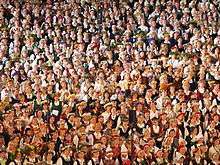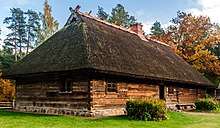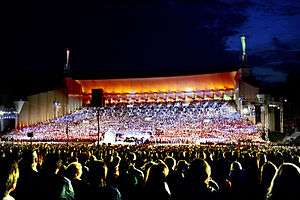Culture of Latvia
The culture of Latvia combines traditional Latvian and Livonian heritage with influences of the country's varied historical heritage.
| Part of a series on the |
| Culture of Latvia |
|---|
 |
| History |
| People |
| Languages |
|
Mythology and folklore
|
| Cuisine |
| Festivals |
| Religion |
| Art |
| Literature |
|
Music and performing arts |
|
Media |
| Sport |
|
Monuments |
|
History
The area of Latvia has been inhabited since 9000 BC. Baltic tribes, the ancestors of present-day Latvians, arrived around 3000 BC. In the 13th century after the conquest of today's Latvia, Baltic Germans settled here and gradually became the upper class and rulers of Latvia, while Latvians and Livonians lost their positions finally becoming serfs in the 16th century. This caused the Germanisation of the educated inhabitants of other nationalities, yet preserved some local traditions. In the 19th century, when serfdom was abolished, a Latvian nationalist movement, the First Latvian National Awakening, begun. Led by "Young Latvians", it encouraged Latvians to become artists and scholars, while preserving their cultural heritage and the language. The movement was countered by a period of Russification, followed by the leftist movement New Current at the beginning of the 20th century; it is regarded as a period in which Latvian culture thrived. This caused the second "Latvian National Awakening", leading ultimately to the proclamation of an independent Latvia in 1918.
On 15 May 1934, Kārlis Ulmanis seized power in a coup d'etat and established an authoritarian regime, which lasted only until the outbreak of World War II and Soviet occupation in 1939–40. In cultural terms, however, this period is seen as a "golden age" for Latvia. During the war, with a period of German occupation from 1941–45, Latvia lost its de facto independence as it was occupied by the USSR and became the Latvian SSR. Soviet rule ended in 1991 during the third "Latvian National Awakening" and the restoration of independence.
People

The majority of inhabitants are Latvians.[1] There is a culturally and linguistically distinct subgroup, the Latgalians, who inhabit the Latgale region in eastern Latvia. Another indigenous group are the Livonians, whose Finnic Livonian language is nearly extinct. The largest minority group is the Slavic people, notably Russians. Other well known minorities are Romani people, Baltic Germans and Jews, whose population decreased significantly after the Second World War, as well as Lithuanians and Estonians.
Religion
Until the 12th century, Latvians were naturalists or otherwise known as pagans, Christianity arrived in the 12th and 13th century and was the most influential religion in the region until the arrival of Communism in the 20th century when all religions were banned. Today the majority of Latvians are part of the Lutheran Church with large Catholic and Orthodox Christian minorities.[2]
Regions

Latvia is divided into several cultural and historical regions: Vidzeme, Latgale, Courland and Zemgale. Sometimes, Sēlija and Maliena are also distinguished.
Folklore
Latvians have the rich heritage of traditional folklore, especially folk songs. Dating back well over a thousand years, more than 1.2 million texts and 30,000 melodies of folk songs have been identified.[3]
Literature
Music
Choir traditions are very strong in Latvia. Alongside many professional choirs, there are tens of thousands of Latvians who are part of different amateur choirs. Once every five years the Latvian National Song and Dance Festival takes place with around 20,000 singers taking part in it.
The 2014 World Choir Games took place in Riga.
In summer 2019 Latvia hosted the inaugural Riga Jurmala Music Festival, a new festival in which world-famous orchestras and conductors performed across four weekends during the summer. The festival took place at the Latvian National Opera, the Great Guild, and the Great and Small Halls of the Dzintari Concert Hall. This year features the Bavarian Radio Symphony Orchestra, the Israel Philharmonic Orchestra, the London Symphony Orchestra and the Russian National Orchestra.[4]
Architecture

A form of traditional architecture in Latvia is log houses. The position of houses differs among regions. In western Latvia, single farms are more popular and in villages, the houses are positioned in a circle around a central square. In eastern Latvia, villages are more popular and houses are positioned along the main street. This is seen as an influence of nearby Russia.
Culture Canon
Launched in 2007 and now complete, the Latvian Culture Canon was selected by a series of groups of experts in the areas of architecture and design, cinema, literature, music, stage art, national traditions and visual arts. It contains a total of 99 works.[5]
See also
- Latvian Gambit (in Chess)
References
- Social Statistics Department of Latvia. "Latvijas iedzīvotāju etniskais sastāvs" (PDF). Social Statistics Department of Latvia. Archived from the original (PDF) on 3 May 2018. Retrieved 21 June 2015.
- "Latvia - Language, Culture, Customs and Etiquette". www.commisceo-global.com. Retrieved 2017-10-29.
- http://www.li.lv/index.php?option=com_content&task=view&id=40&Itemid=124
- https://riga-jurmala.com
- "Latvian Culture Canon". kulturaskanons.lv. Retrieved 2020-05-06.
External links


.svg.png)